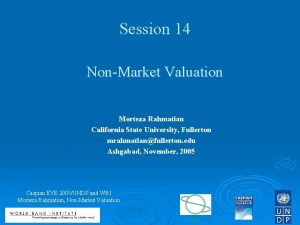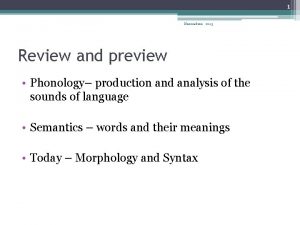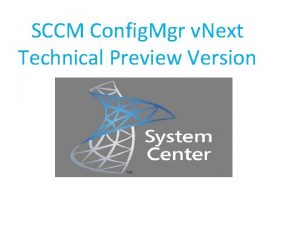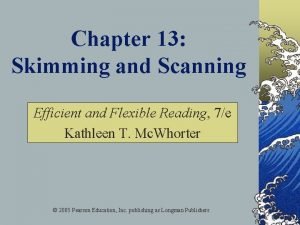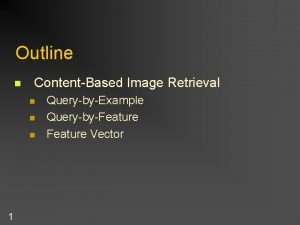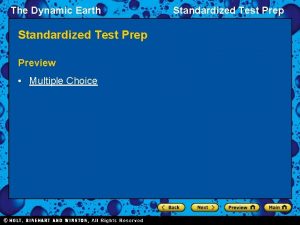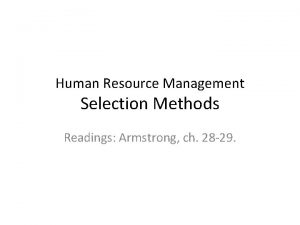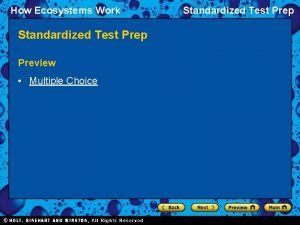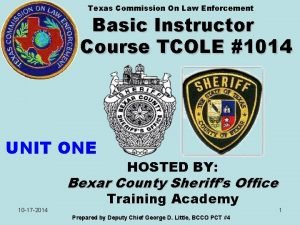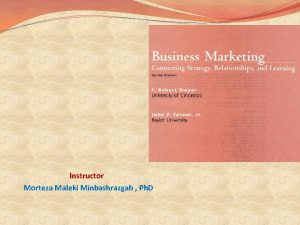Instructor Morteza Maleki Ph D 1 Preview The






























































- Slides: 62

Instructor Morteza Maleki, Ph. D 1


Preview ü The popularity of mix method is due to the fact that research methodology continues to evolve and develop, and mixed methods is another step forward, utilizing the strengths of both qualitative and quantitative research. ü Problems addressed by social and health science researchers are complex, and the use of either quantitative or qualitative approaches by themselves is inadequate to address this complexity. 3

Preview ü The interdisciplinary nature of research contributes to the formation of research teams with individuals with diverse methodological interests and approaches. ü There is more insight to be gained from the combination of both qualitative and quantitative research than either form by itself. ü Their combined use provides an expanded understanding of research problems. 4

Components of Mix Method Procedures ü The first book published in mix method was: ü The Handbook of Mixed Methods in the Social & Behavior Sciences (Tashakkori & Teddlie, 2003). ü Several journals emphasize mixed methods research 1. 2. 3. The Journal of Mixed Methods Research Quality and Quantity Field Methods ü Numerous other journals actively encourage this form of inquiry: 1. 2. 3. International Journal of Social Research Methodology, Qualitative Health Research, Annals of Family Medicine 5

Components of Mix Method Procedures ü A checklist of questions for designing a mixed methods study are as follows: 1. Is a basic definition of mixed methods research provided? 2. Is a reason given for using both quantitative and qualitative approaches (or data)? 3. Does the reader have a sense for the potential use of a mixed methods design? 4. Are the criteria Identified for choosing a mixed methods strategy? 5. Is the strategy identified, and are its criteria for selection given? 6. Is a visual model presented that illustrates the research strategy? 6

Components of Mix Method Procedures 7) Is the proper notation used In presenting the visual model? 8) Are procedures of data collection and analysis mentioned as they relate to the model? 9) Are the sampling strategies for both quantitative and qualitative data collection mentioned? Do they relate to the strategy? 10) Are specific data analysis procedures indicated? Do they relate to the strategy? 11) Are the procedures for validating both the quantitative and qualitative data discussed? 12) Is the narrative structure mentioned, and does it relate to the type of mixed methods strategy being used? 7

The Nature of Mix Method Research The Trace and Definition of Mix Method ü Several sources identify its inception in psychology and in the multitraitmultimethod matrix of Campbell and Fiske (1959) to interest in converging or triangulating different quantitative and qualitative data sources (Jick, 1979) and on to the development of a distinct methodology of inquiry (Creswell & Plano Clark, 2007; Tashakkori & Teddlie, 1998). ü Mix method combines both quantitative and qualitative research and methods in a research study. ü This highlights the reasons why researchers employ a mixed methods design (e. g. , to broaden understanding by incorporating both qualitative and quantitative research, or to use one approach to better understand, explain, or build on the results from the other approach). 8

The Nature of Mix Method Research ü The growth of interest in mixed methods research as expressed in books, journal articles, diverse disciplines, and funded projects has been momentous. ü This form of research poses some challenges for the inquirer; These include 1) The need for extensive data collection, 2) The time-intensive nature of analyzing both text and numeric data, and 3) The requirement for the researcher to be familiar with both quantitative and qualitative forms of research. 9

Types of Mix Method Strategies and Visual Models Planning Mixed Methods Procedures Aspects that influence the design of procedures for a mixed methods study: I. Timing ü Proposal developers need to consider the timing of their qualitative and quantitative data collection, ü Whether it will be in phases (sequentially) or gathered at the same time (concurrently). ü When the data are collected in phases, either the qualitative or the quantitative data can come first; it depends on the initial intent of the researcher. ü When qualitative data are collected first, the intent is to explore the topic with participants at sites. ü The researcher expands the understanding through a second phase in which data are collected from a large number of people (typically a sample representative of a population). 10

Types of Mix Method Strategies and Visual Models ü When data are collected concurrently, both quantitative and qualitative data are gathered at the same time and the implementation is simultaneous. ü In many projects it may be unworkable to collect data over an expanded time period (e. g. , in the health sciences when busy medical personnel have limited time for data collection in the field). ü In this case, it is more manageable to collect both quantitative and qualitative data at roughly the same time, ü The researcher(s) is in the field collecting data, rather than to revisit the field multiple times for data collection. 11

Types of Mix Method Strategies and Visual Models II. Weighting ü The weight or priority given to quantitative or qualitative research in a particular study. ü In some studies, the weight might be equal; in other studies, it might emphasize one or the other. ü A priority for one type depends on 1) 2) 3) The interests of the researcher The audience for the study (e. g. faculty committee, Professional association), What the investigator seeks to emphasize in the study. 12

Types of Mix Method Strategies and Visual Models ü In practical terms, weight occurs in a mixed methods study through such strategies as ü ü ü Whether quantitative or qualitative information is emphasized first, The extent of treatment of one type of data or the other in the project, or The use of primarily an inductive approach (i. e. , generating themes in qualitative) or a deductive approach (i. e. testing a theory). ü Sometimes the researcher intentionally uses one form of data in a supportive role to a larger study, as is found in some experimental trials (Rogers et al. , 2003). 13

Types of Mix Method Strategies and Visual Models III. Mixing ü Mixing the data (and in a larger sense, mixing the research questions, philosophy, the interpretation) is difficult at best when one considers that qualitative data consists of text and images and quantitative data, numbers. ü There are two different questions here: 1) 2) When does a researcher mix in a mixed methods study? How does mixing occur? ü Mixing of the two types of data might occur at several stages: 1) 2) 3) 4) The data collection, The data analysis, Interpretation, or At all three phases. 14

Types of Mix Method Strategies and Visual Models ü How the data are mixed has received considerable recent attention (Creswell & Plano Clark, 2007). ü Mixing means either that 1. 2. 3. The qualitative and quantitative data are actually merged on one end of the continuum, Kept separate on the other end of the continuum, or Combined in some way between these two extremes. ü The two data bases might be kept separate but connected; ü For example, in a two-phase project that begins with a quantitative phase, the analysis of the data and its results can be used to identify participants for qualitative data collection in a follow-up phase. ü In this situation, the quantitative and qualitative data are connected during the phases of research. 15

Types of Mix Method Strategies and Visual Models 1. Connected in mixed methods research means a mixing of the quantitative and qualitative research are connected between a data analysis of the first phase of research and the data collection of the second phase of research. 2. In integrating the data, the researcher might collect both quantitative and qualitative data concurrently and integrate or merge the two databases by transforming the qualitative themes into counts and comparing these counts with descriptive quantitative data. 3. The researcher might have a primary aim to collect one form of data (say quantitative) and have the other form of data (say qualitative) provide supportive information. ü ü The researcher is embedding a secondary form of data within a larger study having a different form of data as the primary database. The secondary database provides a supporting role in the study. 16

Types of Mix Method Strategies and Visual Models IV. Theorizing or Transforming Perspectives ü A final factor to consider is whether a larger, theoretical perspective guides the entire design. ü It may be a theory from the social sciences (e. g. , adoption theory, leadership theory, attribution theory) or a broad theoretical lens, such as an advocacy/participatory lens (e. g. , gender, race, class). ü All researchers bring theories, frameworks and hunches to their inquiries. ü In mixed methods studies, theories are found typically in the beginning sections as an orienting lens that shapes the types of questions asked, who participates in the study, how data are collected, and the implications made from the study (typically for change and advocacy). 17

Types of Mix Method Strategies and Visual Models 18

Types of Mix Method Strategies and Visual Models Alternative Strategies and Visual Models ü There are six major strategies for inquirers to choose from in designing a research proposal (Creswell et al, 2003); ü A proposal would contain 1. 2. 3. A description of the strategy A visual model of it. Basic procedures that the investigator will use in implementing the strategy. 19

Types of Mix Method Strategies and Visual Models ü Mixed Methods Notation provides shorthand labels and symbols that convey important aspects of mixed methods research, and it provides a way that mixed methods researchers can easily communicate their procedures. ü The following notation is adapted from Morse (1991), Tashakkori and Teddlie (1998), and Creswell and Plano Clark (2007). ü A "+" indicates a simultaneous or concurrent form of data collection, with both quantitative and qualitative data collected at same time. ü A” “ indicates a sequential form of data collection, with one form (e. g. qualitative data) building on the other (e. g. quantitative data). 20

Types of Mix Method Strategies and Visual Models ü Capitalization indicates a weight or priority on the quantitative or qualitative data, analysis, and interpretation in the study. ü ü In a mixed methods study, the qualitative and quantitative data may be equally emphasized, or one may be more emphasized than the other. Capitalization indicates that an approach or method is emphasized. ü "Quan" and "Qual" stand for quantitative and qualitative, respectively, and they use the same number of letters to indicate equality between the forms of data. ü A QUAN/qual notation indicates that the qualitative methods are embedded within a quantitative design. ü Boxes highlight the quantitative and qualitative data collection and analysis. 21

Types of Mix Method Strategies and Visual Models 1) Sequential Explanatory Strategy ü The sequential explanatory strategy is a popular strategy for mixed methods design that often appeals to researchers with strong quantitative leanings. ü It is characterized by the collection and analysis of quantitative data in a first phase of research followed by the collection and analysis of qualitative data in a second phase that builds on the results of the initial quantitative results. 22

Types of Mix Method Strategies and Visual Models ü Weight typically is given to the quantitative data, and the mixing of the data occurs when the initial quantitative results informs the secondary qualitative data collection. ü ü The two forms of data are separate but connected. An explicit theory may or may not inform the overall procedure. ADDVANTAGES: ü The straightforward nature of this design is one of its main strengths. ü It is easy to implement because the steps fall into clear, separate stages. ü This design feature makes it easy to describe and to report. DRAWBACK: ü The length of time involved in data collection, with the two separate phases. ü This is especially a drawback if the two phases are given equal priority. 23

Types of Mix Method Strategies and Visual Models 2) Sequential Exploratory Strategy ü It involves a first phase of qualitative data collection and analysis, followed by a second phase of quantitative data collection and analysis that builds on the results of the first qualitative phase. ü Weight is generally placed on the first phase, and the data are mixed through being connected between the qualitative data analysis and the quantitative data collection. 24

Types of Mix Method Strategies and Visual Models ü The purpose of this strategy is to use quantitative data and results to assist in the interpretation of qualitative findings. ü Unlike the sequential explanatory approach, which is better suited to explaining and interpreting relationships, the primary focus of this model is to initially explore a phenomenon. suggested that this design is appropriate to use elements of an emergent theory resulting from the qualitative phase and that used to generalize qualitative findings to different samples. ü Morgan (1998) when testing it can also be 25

Types of Mix Method Strategies and Visual Models ü Morse (1991) ü cited one purpose for selecting this approach: To determine the distribution of a phenomenon within a chosen population. ü It is often discussed as the procedure of choice when a researcher needs to develop an instrument because existing instruments are inadequate or not available. ü Using a three-phase approach, the researcher (Creswell & Plano Clark, 2007): 1. 2. 3. First gathers qualitative data and analyzes it (Phase 1), Second uses the analysis to development an instrument (Phase 2) Third, administer that instrument subsequently to a sample of a population (Phase 3); 26

Types of Mix Method Strategies and Visual Models ADVANTAGES Its two-phase approach (qualitative research followed by quantitative research) makes it easy to implement and straightforward to describe and report. 2) It is useful to a researcher who wants to explore a phenomenon but also wants to expand on the qualitative findings. 3) This model is especially advantageous when a researcher is building a new instrument. 4) This model could make a largely qualitative study more palatable to an adviser, committee, or research community well versed in quantitative research and that may be unfamiliar with the qualitative approaches. 1) DRAWBACKS: 1. 2. It requires a substantial length of time to complete both data collection phases. The researcher has to make some key decisions about which findings from the initial qualitative phase will be focused on in the subsequent quantitative phase (e. g. one theme, comparisons among groups, multiple themes). 27

Types of Mix Method Strategies and Visual Models 3) Sequential Transformative Strategy ü It is a two-phase project with a theoretical lens (e. g. , gender, race, social science theory) overlaying the sequential procedures. ü It has an initial phase (either quantitative or qualitative) followed by a second phase (either qualitative or quantitative) that builds on the earlier phase. 28

Types of Mix Method Strategies and Visual Models ü The theoretical lens is introduced in the introduction to a proposal, shapes a directional research question aimed at exploring a problem (e. g. inequality. Discrimination, injustice), creates sensitivity to collecting data from marginalized or underrepresented groups, and ends with a call for action. ü In this design, the researcher may use either method in the first phase of research, and the weight can be given to either or distributed evenly to both phases. ü The mixing is connected as in all sequential designs. 29

Types of Mix Method Strategies and Visual Models ü Unlike the sequential exploratory and explanatory approaches, the sequential transformative model has a theoretical perspective to guide the study. ü The aim of this theoretical perspective, whether it be a conceptual framework, a specific ideology, or advocacy, is more important in guiding the study than the use of methods alone. ü By using two phases, a sequential transformative researcher may be able to give voice to diverse perspectives, to better advocate for participants, or to better understand a phenomenon or process that is changing as a result of being studied. 30

Types of Mix Method Strategies and Visual Models ADVANTAGES 1. Its use of distinct phases facilitates its implementation, description, and sharing of results, although it also requires the time to complete two data collection phases. 2. This design places mixed methods research within a transformative framework. ü This strategy may be more appealing and acceptable to those researchers already using a transformative framework within one distinct methodology, such as qualitative research. DRAWBACKS 1. Because little has been written to date on this approach, there is little guidance on how to use the transformative vision to guide the methods. 2. Key decisions need to be made about what findings in the first phase will be the focus of the second phase. 31

Types of Mix Method Strategies and Visual Models 4) Concurrent Triangulation Strategy ü The researcher collects both quantitative and qualitative data concurrently and then compares the two databases to determine if there is convergence, differences, or some combination. ü Some authors refer to this comparison as confirmation, disconfirmation, crossvalidation, or corroboration (Greene, Caracelli, & Graham, 1989; Morgan, 1998; Steckler, Mc. Leroy, Goodman, Bird. & Mc. Cormick, 1992). 32

Types of Mix Method Strategies and Visual Models ü In this approach, the quantitative and qualitative data collection is concurrent, happening in one phase of the research study. ü Ideally, the weight is equal between the two methods, but often in practice, priority may be given to one or the other. ü The mixing during this approach, usually found in an interpretation or discussion section, is to actually merge the data (i. e. transform one type of data to the other type of data so that they can easily be compared) or integrate or compare the results of two databases side by side in a discussion. ü This side-by-side integration is often seen in published mixed methods studies ü A discussion section first provides quantitative statistical results followed by qualitative quotes that support or disconfirm the quantitative results. 33

Types of Mix Method Strategies and Visual Models ADVANTAGES 1. 2. It is advantageous because it is familiar to most researchers and can result in well-validated and substantiated findings. The concurrent data collection results in a shorter data collection time period as compared to one of the sequential approaches because both the qualitative and quantitative data are gathered at one time at the research site. LIMITATIONS It requires great effort and expertise to adequately study a phenomenon with two separate methods. 2. It also can be difficult to compare the results of two analyses using data of different forms. 3. A researcher may be unclear how to resolve discrepancies that arise in comparing the results, 1) Conducting additional data collection to resolve the discrepancy, 2) Revisiting the original database, 3) Gaining new insight from the disparity of the data, or 4) Developing a new project that addresses the discrepancy (Creswell & Plano Clark, 2007). 1. 34

Types of Mix Method Strategies and Visual Models 5) Concurrent Embedded Strategy ü It uses one data collection phase, during which both quantitative and qualitative data are collected simultaneously. ü Unlike the traditional triangulation model, a concurrent embedded approach has a primary method that guides the project and a secondary database that provides a supporting role in the procedures. 35

Types of Mix Method Strategies and Visual Models ü Given less priority, the secondary method (quantitative or qualitative) is embedded, or nested, within the predominant method (qualitative or quantitative). ü This embedding may mean that the secondary method addresses a different question than the primary method (e. g. , in an experiment, the quantitative data addresses the outcomes expected from the treatments while the qualitative data explores the processes experienced by individuals in the treatment groups) or seeks information at a different level of analysis (the analogy to hierarchical analysis in quantitative research is helpful in conceptualizing these levels) (Tashakkori and Teddlie, 1998). 36

Types of Mix Method Strategies and Visual Models ü The mixing of the data from the two methods is often to integrate the information and compare one data source with the other, typically accomplished in a discussion section of a study. ü The data may also not be compared but reside by side as two different pictures that provide an overall composite assessment of the problem. ü This would be the case when the researcher uses this approach to assess different research questions or different levels in an organization. ü Similar to the other approaches, an explicit theoretical perspective can be used in this model, typically to inform the primary method. 37

Types of Mix Method Strategies and Visual Models ü This model is used so that a researcher can gain broader perspectives as a result of using the different methods as opposed to using the predominant method alone. ü According to Morse (1991), a primarily qualitative design could embed some quantitative data to enrich the description of the sample participants. ü Qualitative data could be used to describe an aspect of a quantitative study that cannot be quantified. 38

Types of Mix Method Strategies and Visual Models ü A concurrent embedded model may be employed when a researcher chooses to utilize different methods to study different groups or levels. ü ü For example, if an organization is being studied, employees could be studied quantitatively, managers could be interviewed qualitatively, entire divisions could be analyzed with quantitative data, and so forth. Tashakkori and Teddlie (1998) described this approach as a multilevel design. 39

Types of Mix Method Strategies and Visual Models ü One method could be used within a framework of the other method. ü If a researcher designed and conducted an experiment to examine treatment outcomes but used case study methodology to study how participants in the study experienced the treatment procedures. 40

Types of Mix Method Strategies and Visual Models ADVANTAGES 1) A researcher is able to collect the two types of data simultaneously, during a single data collection phase. 2) It provides a study with the advantages of both quantitative and qualitative data. 3) By using the two different methods in this fashion, a researcher can gain perspectives from the different types of data or from different levels within the study. DRAWBACKS 1) The data need to be transformed in some way so that they can be integrated within the analysis phase of the research. 2) If the two databases are compared, discrepancies may occur that need to be resolved. 3) Because the two methods are unequal in their priority, this approach also results in unequal evidence within a study, which may be a disadvantage when interpreting the final results. 41

Types of Mix Method Strategies and Visual Models 6) Concurrent Transformative Strategy ü It is guided by the researcher's use of a specific theoretical perspective as well as the concurrent collection of both quantitative and qualitative data. ü This perspective can be based on ideologies such as critical theory, advocacy, participatory research, or a conceptual or theoretical framework. 42

Types of Mix Method Strategies and Visual Models ü It is the driving force behind all methodological choices, such as defining the problem, identifying the design and data sources, analyzing, interpreting, and reporting results. ü The choice of a concurrent model, whether it is triangulation or embedded design, is made to facilitate this perspective. ü ü For example, the design may have one method embedded in the other so that diverse participants are given a voice in the change process of an organization. It may involve a triangulation of quantitative and qualitative data to best converge information to provide evidence for an inequality of policies in an organization. ü It may take on the design features of either a triangulation or an embedded approach (the two types of data are collected at the same time during one data collection phase and may have equal or unequal priority). 43

Types of Mix Method Strategies and Visual Models ü The mixing of the data would be through merging, connecting, or embedding the data. ü Because the concurrent transformative model shares features with the triangulation and embedded approaches, it also shares their specific strengths and weaknesses. ü This model has the added advantage of positioning mixed methods research within a transformative framework, which may make it especially appealing to those qualitative or quantitative researchers already using a transformative framework to guide their inquiry. 44

Types of Mix Method Strategies and Visual Models Choosing a Mix Method Strategy Consider timing, weighting, mixing and theorizing issues to assess aspects that you will be working with in your mixed methods procedures, and then identify one of the six approaches as the primary design for your proposed study. 1. ü Provide a working definition for this design, along with a visual model and a rationale as to why it is a useful design for you. Consider the amount of time you have to collect data. 2. ü Concurrent approaches are less time consuming because both qualitative and quantitative data are collected at the same time in the same visit to the field. 45

Types of Mix Method Strategies and Visual Models The collection and analysis of both quantitative and qualitative data is a rigorous, time-consuming process. 3. ü ü ü When time is a problem, students should think about an embedded model of design. This model emphasizes a major primary form of data collection (e. g. , surveys), and it can include a minor secondary form of data collection (e. g. , a few interviews with some of the participants who completed the surveys). The fact that both forms of data are not equal in size and rigor enables the study to be reduced in scope and manageable for the time and resources available. Consider using the explanatory sequential approach. 4. ü ü It is normally used by those who have little experience with qualitative research and substantial background in quantitative research. In this approach, an initial quantitative data collection is followed by a secondary qualitative data collection to follow up the quantitative results. 46

Types of Mix Method Strategies and Visual Models 5. Study published articles that use different approaches and determine which one makes the most sense to you. 6. Find a published mixed methods journal article that uses your design and introduce it to your adviser and faculty committee so that they have a working model for the approach you plan to use in your study. ü Since we are at the early stage of adopting mixed methods research in many fields, a published example of research in your field will help to create both legitimacy for mixed methods research and the idea that it is a feasible approach to research for graduate committees or other audiences. 47

Data Collection Procedures Factors Critical in Data Collection Identify and be specific about the type of data-both quantitative and qualitative-that will be collected during the proposed study. 1) ü ü ü Data differs in terms of open-ended versus closed-ended responses. Some forms of data, such as interviews and observations, can be either quantitative or qualitative depending on how open (qualitative) or closed (quantitative) the response options might be in an interview or a checklist for an observation. Although reducing information to numbers is the approach used in quantitative research, it is also used in qualitative research. 48

Data Collection Procedures often involve random sampling, so that each individual has an equal probability of being selected, and the sample can be generalized to the larger population. 2) Quantitative data ü In qualitative data collection, purposeful sampling is used so that individuals are selected because they have experienced the central phenomenon. 49

Data Collection Procedures have developed a typology of five types of mixed methods sampling which relates sampling to the strategies for mixed methods: ü Teddlie and Yu (2007) 1) 2) 3) 4) 5) Basic strategies that involve combining quantitative and qualitative sampling (e. g. , stratified purposeful sampling, purposive random sampling). Sequential sampling, in which the sampling from the first phase or strand informs the second phase or strand. Concurrent sampling, in which quantitative probability and qualitative purposeful sampling are combined as independent sampling procedures or jointly (e. g. . a survey with both closed -ended and open-ended responses). Multilevel sampling, in which sampling occurs in two or more levels or units of analysis. Sampling using any combination of the foregoing strategies 50

Data Collection Procedures Include detailed procedures in your visual model. 3) ü For example, in a sequential explanatory model, the general procedures are higher on the page and the detailed procedures below them. ü ü For example, a discussion of this approach might include describing the use of survey data collection followed by both descriptive and inferential data analysis in the first phase. Then qualitative observations and coding and thematic analysis within an ethnographic design might be mentioned for the second phase. 51

Data Analysis and Validation Procedures ü Analysis occurs both within the quantitative (descriptive and inferential numeric analysis) and the qualitative (description and thematic text or image analysis) approach and often between the two approaches. ü For example, some of the more popular mixed methods data analysis approaches are the following (Caracelli & Greene, 1993; Creswell & Plano Clark, 2007; Tashakkori & Teddlie, 1998); 1) Data transformation 2) Explore outliers 3) Instrument development 4) Examine multiple levels 5) Create a matrix 52

Data Analysis and Validation Procedures I. Data Transformation ü In the concurrent strategies, a researcher may quantify the qualitative data. ü This involves creating codes and themes qualitatively, then counting the number of times they occur in the text data (or possibly the extent of talk about a code or theme by counting lines or sentences). ü This quantification of qualitative data then enables a researcher to compare quantitative results with the qualitative data. ü An inquirer may qualify quantitative data. ü For instance, in a factor analysis of data from a scale on an instrument, the researcher may create factors or themes that then can be compared with themes from the qualitative database. 53

Data Analysis and Validation Procedures II. Explore Outliers ü In a sequential model, an analysis of quantitative data in the first phase can yield extreme or outlier cases. ü Follow-up qualitative interviews with these outlier cases can provide insight about why they diverged from the quantitative sample. III. Instrument development: ü In a sequential approach, first, obtain themes and specific statements from participants in an initial qualitative data collection. ü In the next phase, use these statements as specific items and themes for scales to create a survey instrument that is grounded in the views of the participants. ü A third phase might be to validate the instrument with a large sample representative of a population. 54

Data Analysis and Validation Procedures IV. Examine Multiple Levels ü In a concurrent embedded model, conduct a survey at one level (e. g. , with families) to gather quantitative results about a sample. ü At the same time, collect qualitative interviews (e. g. , with individuals) to explore the phenomenon with specific individuals in the families. 55

Data Analysis and Validation Procedures VI. Create a Matrix ü When comparing data in a concurrent type of approach, combine information from both the quantitative and qualitative data collection into a matrix. ü The horizontal axis of this matrix could be a quantitative categorical variable (e. g. , type of provider-nurse, physician, and medical assistant) and the vertical axis would be the qualitative data (e. g. , five themes about caring relationships between providers and patients). ü Information in the cells could be either quotes from the qualitative data, counts of the number of codes from the qualitative data, or some combination. ü In this way, the matrix would present an analysis of the combined qualitative and quantitative data. ü Qualitative computer software programs provide matrix output capabilities for the mixed methods researcher. 56

Data Analysis and Validation Procedures ü Another aspect of data analysis in mixed methods research is to check the validity of both the quantitative data and the accuracy of the qualitative findings. ü In mixed methods, the use of validity procedures for both the quantitative and qualitative phases of the study is recommended (Tashakkori & Teddlie, 1998). ü ü The validity and reliability of the scores from past uses of instruments employed in the study should be discussed. Potential threats to internal validity for experiments and surveys should be noted. ü For the qualitative data, the strategies that will be used to check the accuracy of the findings need to be mentioned; these may include 1) 2) 3) Triangulating data sources, Member checking, Detailed description. 57

Data Analysis and Validation Procedures How validity might be different for mixed methods studies than for a quantitative or a qualitative study? ü A bilingual nomenclature for mixed methods research and have called validity legitimation (Onwuegbuzie & Johnson, 2006, p. 55). ü The legitimation of the mixed methods study relates to many phases of the research process, from philosophical issues (e. g. , are the philosophical positions blended into a usable form? ) to inferences drawn (e. g. , yield high-quality inferences) and to the value of the study for consumers (Onwuegbuzie & Johnson, 2006). ü Validity issues in mixed methods research may relate to the types of strategies. ü These may relate to sample selection, sample size, follow up on contradictory results, bias in data collection, inadequate procedures, or the use of conflicting research questions (Creswell & Plano Clark, 2007) 58

Report Presentation Structure Sequential Mix Method ü For a sequential study, mixed methods researchers typically organize the report of procedures into quantitative data collection and quantitative data analysis followed by qualitative data and collection and analysis. ü In the conclusions or interpretation phase of the study, the researcher comments on how the qualitative findings helped to elaborate on or extend the quantitative results. ü The qualitative data collection and analysis could come first, followed by the quantitative data collection and analysis. ü In either structure, the writer typically presents the project as two distinct phases, with separate headings for each phase. 59

Report Presentation Structure Concurrent Mix Method ü In a concurrent study, the quantitative and qualitative data collection may be presented in separate sections, but the analysis and interpretation combines the two forms of data to seek convergence or similarities among the results. ü The structure of this type of mixed methods study does not make a clear distinction between the quantitative and qualitative phases. 60

Report Presentation Structure Transformative Mix Method ü In a transformative study, the structure typically involves advancing the advocacy issue in the beginning and then using either the sequential or concurrent structure as a means of organizing the content. ü In the end, a separate section may advance an agenda for change or reform that has developed as a result of the research. 61

The End
 Morteza maleki
Morteza maleki Data gathering procedure example
Data gathering procedure example Insertion sort pseudocode
Insertion sort pseudocode Morteza farajian
Morteza farajian Morteza anvari
Morteza anvari Morteza farajian
Morteza farajian Morteza katouzian
Morteza katouzian Morteza farajian
Morteza farajian Cost analysis requirements description
Cost analysis requirements description Morteza farajian
Morteza farajian Morteza rahmatian
Morteza rahmatian Review and preview
Review and preview The four agreements preview
The four agreements preview Sccm technical preview
Sccm technical preview Test prep preview
Test prep preview Preview speech
Preview speech Yandex.ru video
Yandex.ru video Test prep preview
Test prep preview Nnn preview
Nnn preview Example of thesis statement
Example of thesis statement Realistic job preview pros and cons
Realistic job preview pros and cons Test prep preview
Test prep preview Preview statement speech example
Preview statement speech example Chapter 7 intercultural communication
Chapter 7 intercultural communication Overview skimming
Overview skimming Nút lệnh print preview nằm ở đâu
Nút lệnh print preview nằm ở đâu The selection preview
The selection preview Test prep preview
Test prep preview Thesis and preview statement example
Thesis and preview statement example Disadvantages of realistic job preview
Disadvantages of realistic job preview Perintah print preview kita jalankan dari menu
Perintah print preview kita jalankan dari menu What is a preview statement
What is a preview statement Nnn image preview
Nnn image preview What is tams
What is tams Chapter 21 standardized test practice answers
Chapter 21 standardized test practice answers Test prep preview
Test prep preview Test prep preview
Test prep preview Multi-channeled definition in communication
Multi-channeled definition in communication 1984 book preview
1984 book preview Classic trio' of selection techniques
Classic trio' of selection techniques Test prep preview
Test prep preview Menu collections pane di windows movie maker berguna untuk
Menu collections pane di windows movie maker berguna untuk Delmar cengage learning instructor resources
Delmar cengage learning instructor resources Medical terminology instructor
Medical terminology instructor Nra certified instructor logo
Nra certified instructor logo Human factors instructor
Human factors instructor Instructor vs teacher
Instructor vs teacher Tcole advanced instructor course
Tcole advanced instructor course Ac61-98 plan of action
Ac61-98 plan of action How to become an nrp instructor mentor
How to become an nrp instructor mentor Basic instructor course texas
Basic instructor course texas Basic instructor course #1014
Basic instructor course #1014 Tipos de participantes en un grupo
Tipos de participantes en un grupo Basic instructor course #1014
Basic instructor course #1014 Instructor office hours
Instructor office hours Naismith was an instructor of
Naismith was an instructor of Instructor operating station
Instructor operating station Cisco certified trainer
Cisco certified trainer Jrotc marksmanship instructor course online
Jrotc marksmanship instructor course online Utp cable
Utp cable The virtual instructor
The virtual instructor Pepperball training manual
Pepperball training manual Basic instructor course tcole
Basic instructor course tcole










